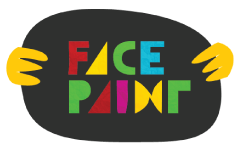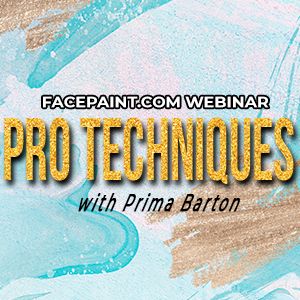In this webinar, learn the important things about face painting with Bianca Hannah.
So I wanna get straight in and start talking about paints themselves. Paint is what we use and it's important to know about it, right? So I have here a Kraze container and if you go to the back, there is a little symbol here with a number inside and here it says "12 months". This is very important information. What that means is as soon as you open that paint and use it, from that moment on you have 12 months to use it. This is kind of like an expiration date. If you start using these paints, you should go ahead and write a little date or something on your container so you know when you started using it and I'm pretty sure that very few people do that but it is actually an important thing to do. Also, when you repot your paints or when you make your own split cakes, you should write down the information when you did it, what kind of paints are in that split cake and keep track of that. It’ll help you in the future if you wanna order stuff. It will help you realize or learn how long that cake lasts, etc. So it really helps. You wanna work clean and professional as a face painter and not paint with 10-year-old paints.
Let's talk about repotting. There are several reasons why I repot my paints. First is I wanna make my paints fit. They don't always fit how I need them and sometimes you have to work small. My travel case is quite small and there's no way I can fit all these big, round containers and every single paint in this little itty bitty case. And I've been to conventions with this case and it really worked out great. But I had to repot and fix the paints the way I need it, otherwise there's no way to get them in. Also, I wanted to share a quick trick that I do with my magnets because I thought that's pretty neat. So I magnetize my stencils with a regular magnet and I made sure all of them were N50 because you want them to be strong so that it holds all that weight. Then I mark it on one side with white tape, and the other side I leave blank. And they're all in the same direction [so all of your stencils are together]. It saves you time, it’s very helpful and pretty neat.
When I repot my paints, I sometimes like to use different brands together in a cake because it makes sense, for me, to do so. When you have paints with different bases together, it takes a little bit more effort for them to mix and sometimes I use that to my advantage when I want that contrast; when I want that white to stay white and then I use that for that purpose.
I was always concerned about if I would lose my insurance coverage if I repot my paints. I just asked my insurance and they immediately answered, "No, you don't. You are covered, girl" and that's awesome. That's good news to hear.
Let me talk about repotting a little more. When I repot, I try to work as clean as I possibly can. I sanitize the whole working area, sanitize my hands, wear gloves, wash my hands, wash them anyway even if you wear gloves, and try to really work as clean as possible. So when I make a rainbow cake, I cut my stripes, put them into a container, and when it's in there you should always take a wipe or a paper towel and then just press it down. Press the whole area down as good as you can. This is really important, please do this when you repot your paints, even when you just put a single color in. The reason why it's really important to do that is you don't want to have any gaps in there and you don't want the water to disappear and work their way in the gaps and into the paints because first of all, the paints can get gooey, and secondly, the pigments can get picked up and the neighbor paints can bleed into each other.
When you have brand new paints, they have this structure, right? So this structure is like self-protection; it is germophobic, if you wanna call it that, and it's a good thing. We want it that way, right? So when you use these paints and you use too much water on it, the water breaks up this structure and the paint loses its ability to fight germs. We don't want that to happen so try to work with as little water as possible. Don't ever spray on your paints, spray on your sponges.
So let's go to when you use water. So we want to work clean and when you use water, use distilled water. The distilled water that you buy in the store is actually heated up before it's filled so it has no germs when it's getting filled and it actually stays pretty stable that way for quite a while. When you fill your spray bottles that you use for your gig, make sure it is filled with fresh water, like filtered water. You could also boil your water to get rid of the germs. Distilled water does not have minerals either; this is a good thing. You don't want to have extra minerals getting in your paint.
So I have a RinseWell. This is one of those items I never had but once I owned it, it changed the game for me. You fill your water in the container attached to it. And you’re working and stuff and doing whatever you need to do. Once you don't need the water anymore, you just press the button and it disappears right underneath and the fresh water automatically fills up again. This is just wonderful. The client sees that and they'll remember you as someone professional, clean, and it's a positive little memory that the client takes with them and that's what we want.
A lot of paints come with a warning that says "Don't use blue on the lips and don't use red around the eyes". The FDA is actually the one who doesn’t recommend that so I wrote to them and they said the reason is because of staining. They’re pigments and they might stain. It's not that they necessarily do, but they might.
Most neon paints and special FX paints have a label that says "not used for cosmetics". I asked the FDA about that as well, and they said the reason is because those products haven't been tested. So what has to happen is the manufacturer has to send samples to them and every single thing has to get tested and so on. It's a long and probably expensive process, I can imagine that this might be a reason why a lot of the paints aren't tested yet. However, I asked my insurance about that as well and they say using neon paints are fine. I’m under Bodyworks so if you are not with Bodyworks you have to check with your own insurance and see if they cover that as well.
So let's talk about brushes real quick. You shouldn't just leave brushes in a water container. Anything that is a liquid that is exposed to the tip area of a brush for too long will penetrate into the ferrule and it will soak in the unvarnished part and probably destroy the glue that holds the bristles, so you don't want to soak it in water for too long. You also shouldn't store the brushes upright with the tip at the top after cleaning them. You should lay them down on a dry towel and let them dry out.
I wanna talk about sponges too. How do you clean your sponges? So basically, I recommend you take the sponges, take special soap, things like Brush Bath by Silly Farm, soaps that are made to pick up the pigments really good. A lot of soaps break down the structure of viruses and bacterias easily and kill the most. If you really want to clean it some more, take anti-microbial liquid soap as well or use 70% alcohol to clean them. Real quick about alcohol--when you wanna sanitize with alcohol, the alcohol actually has to be on a surface for at least 30 seconds, even better at 50 seconds to be able to kill the bacteria and viruses and fungus and whatnot. If you use 91% alcohol, it evaporates too fast and it doesn't give enough time to kill so 70% or 60% alcohol would work better. So yes, clean sponges by hand washing and soap, and let them dry. I throw them in a microwave for 1 minute. Make sure that you don't overdo it; you don't want to deepfry the sponges, you just want to sanitize for 1 minute. Don't get your sponges clean in a washer, it is actually rather dangerous. Handwashing your sponges makes them last a longer time as well.
Bonus Design: White Roses

So I take my white and activate it. It has to be activated very well and I want to use a lot of the white pre-activated, if that makes any sense. So then the brush (5/8” Blazin Brush) itself, what I do is get it in the RinseWell real quick. I dunk it all the way in because you have to have it wet if you want to carry paint out, and give it a firm press and this gets the excess water off. Then I just put that white on or you can also put that white in or pick that up here and stripe it up on the brush. And then you just start painting your roses. This is wonderful for bridal makeup, it looks very delicate and elegant. And you can paint literally like how you usually paint your roses and just work with it. This is super easy and you can really make a beautiful design. It's actually fairly fast, the way it goes, and it's beautiful. It looks so delicate on the skin and if you use a fixing spray to fix it, you can really offer it for bridal makeup. So that was me.
Products Mentioned in the Webinar:
Kraze containers (Kraze FX Singles - Square)
Kraze FX Palettes
Diamond FX White
Global Standard Dark Blue
RinseWell (Masterson Rinse Well Brush Cleaner)
Silly Farm Brush Bath Cleaner
Eco-Sponges (Bianca Hannah's Sponges)
Blazin Brush Long Angle 5/8"
If you missed the live webinar, you can watch it now in the video above or later at our YouTube channel. Thank you, Bianca, for sharing your talents with us! Thank you to everyone who tuned in to the webinar. Click here to know our upcoming webinars.
 FREE SHIPPING FOR USA ORDERS OVER $100
FREE SHIPPING FOR USA ORDERS OVER $100








Leave a comment (all fields required)